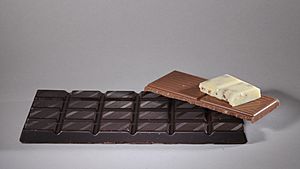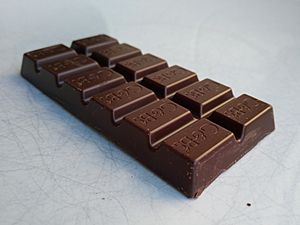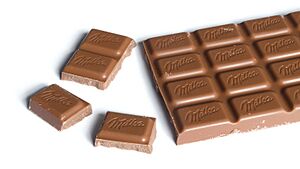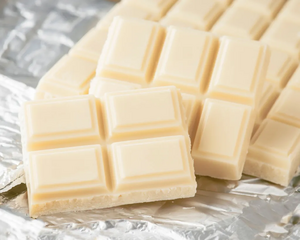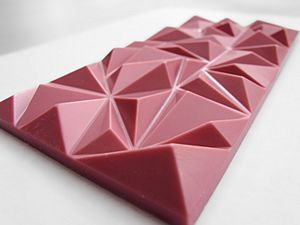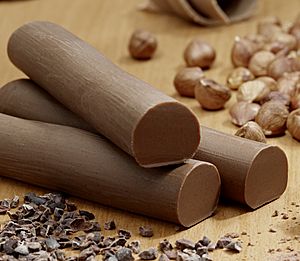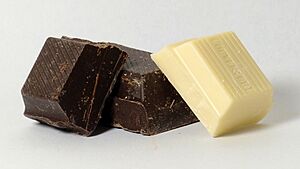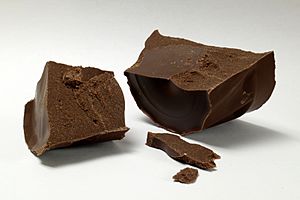Types of chocolate facts for kids
Chocolate is a yummy food product made from cocoa beans. These beans are roasted and ground up, then mixed with fat like cocoa butter and powdered sugar. This mix creates the solid treat we all love! There are many kinds of chocolate, mostly known by how much cocoa and fat they contain. Some countries even have rules about what can be called "chocolate."
Contents
Types of Chocolate
Eating Chocolate
Dark Chocolate
Dark chocolate, also called plain chocolate, is made without milk fat. It uses chocolate liquid, sugar, more cocoa butter, and vanilla. You can eat dark chocolate as is, or use it for baking. Baking bars often have a high cocoa percentage, from 70% to 100%. The more cocoa, the more bitter it tastes. Many brands show the cocoa percentage on their wrapper.
Dark chocolate has some great benefits! It usually has less fat and sugar than other types. It's also full of things called antioxidants, like flavanols, which are good for your heart. Plus, it has a lot of cocoa solids, which helps with its healthy benefits. Rules in the European Union say dark chocolate must have at least 35% cocoa. In the U.S., it needs at least 15% chocolate liquid.
"Bittersweet chocolate" is a type of dark chocolate for baking with less sugar. "Semi-sweet chocolate" has a bit more sugar. Both can usually be used in baking.
Milk Chocolate
Milk chocolate is solid chocolate made with milk. Different brands and places have unique flavors because of how they handle the milk. They might use powdered milk, condensed milk, or other milk forms.
The first known milk chocolate was made in 1839 using donkey milk! Later, in 1875, a Swiss candy maker named Daniel Peter created solid milk chocolate. He used condensed milk, which his neighbor, Henri Nestlé, had invented.
Since the 1920s, Cadbury has been a top milk chocolate brand in the United Kingdom. In the U.S., The Hershey Company is the biggest producer. They have their own special way of making milk chocolate.
White Chocolate
White chocolate feels like milk and dark chocolate, but it doesn't have the dark cocoa parts. It's made from sugar, milk, and cocoa butter, which is the fat from cocoa beans. It's a pale ivory color and doesn't have many of the same compounds as milk or dark chocolate.
White chocolate has the most milk solids of all chocolates, usually 30% or more. Milk chocolate only has about 25%. In 2002, the U.S. Food and Drug Administration (FDA) set rules for white chocolate. It must be made from cocoa fat (cocoa butter), milk solids, sweeteners, and other safe ingredients. But it cannot have any non-fat cocoa solids.
Blonde Chocolate
Blonde chocolate is made by gently heating white chocolate. This process gives it a golden color and creates new flavors, making it taste like caramel. A chef at Valrhona accidentally discovered it in 2006. Valrhona was the first company to sell it in 2012.
Ruby Chocolate
Ruby chocolate is a special type of chocolate made by Barry Callebaut, a company from Belgium and Switzerland. They worked on it since 2004 and released it in 2017. This chocolate comes from a unique "Ruby cocoa bean." It has a distinct red color and a flavor described as "sweet yet sour."
Raw Chocolate
Raw chocolate is chocolate that hasn't been processed much, heated, or mixed with many other things. You can find it in countries where cocoa grows and in other places too. People often say it's very healthy. Raw chocolate has many important antioxidants, minerals, and vitamins. These include protein, iron, and fiber.
Gianduja Chocolate
Gianduja chocolate is made by mixing hazelnut butter with chocolate paste. Like regular chocolate, it comes in plain and milk versions. It can also have other nuts, like almonds. Gianduja bars look like normal chocolate, but they are much softer because of the hazelnut oil.
Vegan Chocolate
Vegan chocolate is like milk chocolate but uses plant milk instead of regular milk. This makes it suitable for people who don't eat animal products.
Organic Chocolate
Organic chocolate is chocolate that has been grown and made using organic methods. This means no chemical fertilizers or pesticides are used on the cocoa beans. It's a growing part of the chocolate world. Many organic chocolate makers get their ingredients from fair trade cocoa farms. This means the farmers are paid fairly for their work.
Chocolate for Baking and Candy
Baking Chocolate
Baking chocolate, or cooking chocolate, is made to be used in baking and sweet foods. It can be dark, milk, or white chocolate. Sometimes, lower quality baking chocolate might not taste as good or feel as smooth as higher quality chocolate.
If chocolate isn't stored well, it might get white spots called chocolate bloom. This happens when sugar or fat separates. It's not harmful and is still safe to eat. In the USA, baking chocolate with no added sugar can be called "unsweetened chocolate."
Couverture Chocolate
Couverture chocolate is a high-quality chocolate. It has more cocoa butter than other chocolates and is carefully prepared. Chefs use it for dipping, coating, molding, and decorating. "Couverture" means "covering" in French. Popular brands include Valrhona, Lindt & Sprüngli, and Callebaut.
Compound Chocolate
Compound chocolate is a mix of cocoa with other vegetable fats, like tropical fats or hardened fats. These fats replace cocoa butter. It's often used for coating candy bars. In many countries, it can't legally be called "chocolate" because it doesn't use enough cocoa butter.
Modeling Chocolate
Modeling chocolate is a chocolate paste. It's made by melting chocolate and mixing it with corn syrup, glucose syrup, or golden syrup. Cake makers and pastry chefs mostly use it to decorate cakes and pastries.
Chocolate Rules Around the World
Different countries have different rules about what can be called "chocolate." These rules often say how much cocoa, fat, and milk must be in the product.
In Canada, for example, chocolate cannot contain other vegetable fats or artificial sweeteners. If a product has these, it must be called something else, like "candy."
The European Union also has rules. They allow up to 5% of a chocolate's fat to come from certain plant oils instead of just cocoa butter.
Japan has a very detailed system for classifying "chocolate materials" and "chocolate products" based on their ingredients.
In the United States, the FDA sets rules for cocoa products. "Semisweet" and "bittersweet" dark chocolates must have at least 35% cocoa solids. The term "chocolate liquor" refers to the ground cocoa bean, which has cocoa butter and solids.
Some chocolate makers have asked the U.S. FDA to change the rules. They want to be able to use other vegetable fats and artificial sweeteners and still call their products "chocolate." Currently, if a product has these ingredients, it's often called "chocolatey" or "made with chocolate."
Possible Side-Effects of Eating Chocolate
Eating dark chocolate, which is rich in cocoa, is usually safe for most people. However, if you eat too much or are sensitive to some ingredients, you might have side effects.
Dark chocolate has a small amount of caffeine. If you are sensitive to caffeine, too much chocolate might cause a fast heartbeat, constipation, nausea, or make you feel restless.
Chocolate allergies and sensitivities are rare, but they can happen. A severe chocolate allergy can cause a serious reaction called anaphylaxis. A chocolate sensitivity might cause milder issues like acne, bloating, or stomach problems.
See also
 In Spanish: Elaboración del chocolate para niños
In Spanish: Elaboración del chocolate para niños


